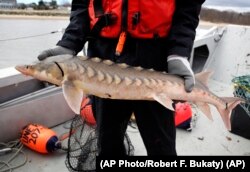Sturgeon once were America’s disappearing dinosaurs. The fish look like prehistoric creatures, with armor plates covering their bodies. They have been around so long, they once swam with dinosaurs.
In modern times, they used to crowd the American rivers. But peoples’ desire for expensive caviar -- fish eggs -- nearly made sturgeon disappear.
More than a century later, some of the huge bottom feeding fish are showing signs of a comeback in American waterways.
Increased numbers are appearing in the cold streams of Maine, the lakes of Michigan and Wisconsin and the dark brown waters of Florida’s Suwannee River.
Greg Garman is an ecologist at Virginia Commonwealth University in Richmond, Virginia. He studies Atlantic sturgeon living in Virginia’s James River. He said there has been a major change in their luck -- for the better.
“We didn’t think they were there, frankly. Now, they’re almost every place we’re looking.”
Taken for their eggs
In the late 1800s, sturgeon fish were taken for their eggs. In the years that followed, America’s nine different kinds of sturgeon were harmed by pollution, dams and overfishing. But the sharp drops in many populations were not fully known until the 1990s.
Scientists have been finding sturgeon in places where they were thought to be long gone. And they are seeing more of them in some rivers because of increasingly clean water, dam removals and fishing bans.
While such news offers hope for one of the world’s most threatened fish, America’s sturgeon population is still just very small compared to what it once was.
Across America, dams still keep some sturgeon populations low because they block ancient paths the fish took to spawn -- or lay their eggs. New threats include rising water temperatures from climate change as well as sharp propellers of ships.
Swam with dinosaurs
Sturgeon swam with the dinosaurs. Bony plates line their bodies. Their toothless mouths move about, taking in anything to eat.
Sturgeon live for a long time, sometimes even longer than humans.
Their meat fed Native Americans and early settlers of the U.S.
Then came caviar. The Russian food of salt-treated sturgeon eggs became popular in Europe. The American sturgeon population suffered greatly.
“People just massacred them, just like we massacred the buffalo,” said writer Inga Saffron. She wrote the 2002 book, “Caviar.”
“Not only did they kill the fish, they killed future generations of fish.”
Sturgeon do not spawn often. Experts say it will take many years to measure their population’s recovery.
Environmentalists say more efforts are needed to help sturgeon populations recover.
“They’ve survived relatively unchanged for 200 million years,” said Jeff Miller, with the Center for Biological Diversity. The group is seeking federal safety measures for sturgeon in the Great Lakes, Mississippi River, and the rivers and streams that flow into them.
He added, “If they’re going to survive us, they’re going to need additional protection.”
I’m Anne Ball.
Ben Finley, Patrick White and John Flesher wrote this story for the Associated Press. Anne Ball adapted it for VOA Learning English. Ashley Thompson was the editor.
Let us know what you think of this story. Write to us in the comments section below.
________________________________________________________________
Words in This Story
armor plate – n. bony pieces along its back for protection
stream – n. a natural flow of water that is smaller than a river
ecologist – n. a scientist that deals with the relationship between groups of living things and their environments
frankly – adv. in an honest and direct way
propeller – n. a device with two or more blades that turn quickly and cause a ship or aircraft to move
massacre – n. the violent killing of many people or living beings
buffalo – n. a large member of the Bovidae family












